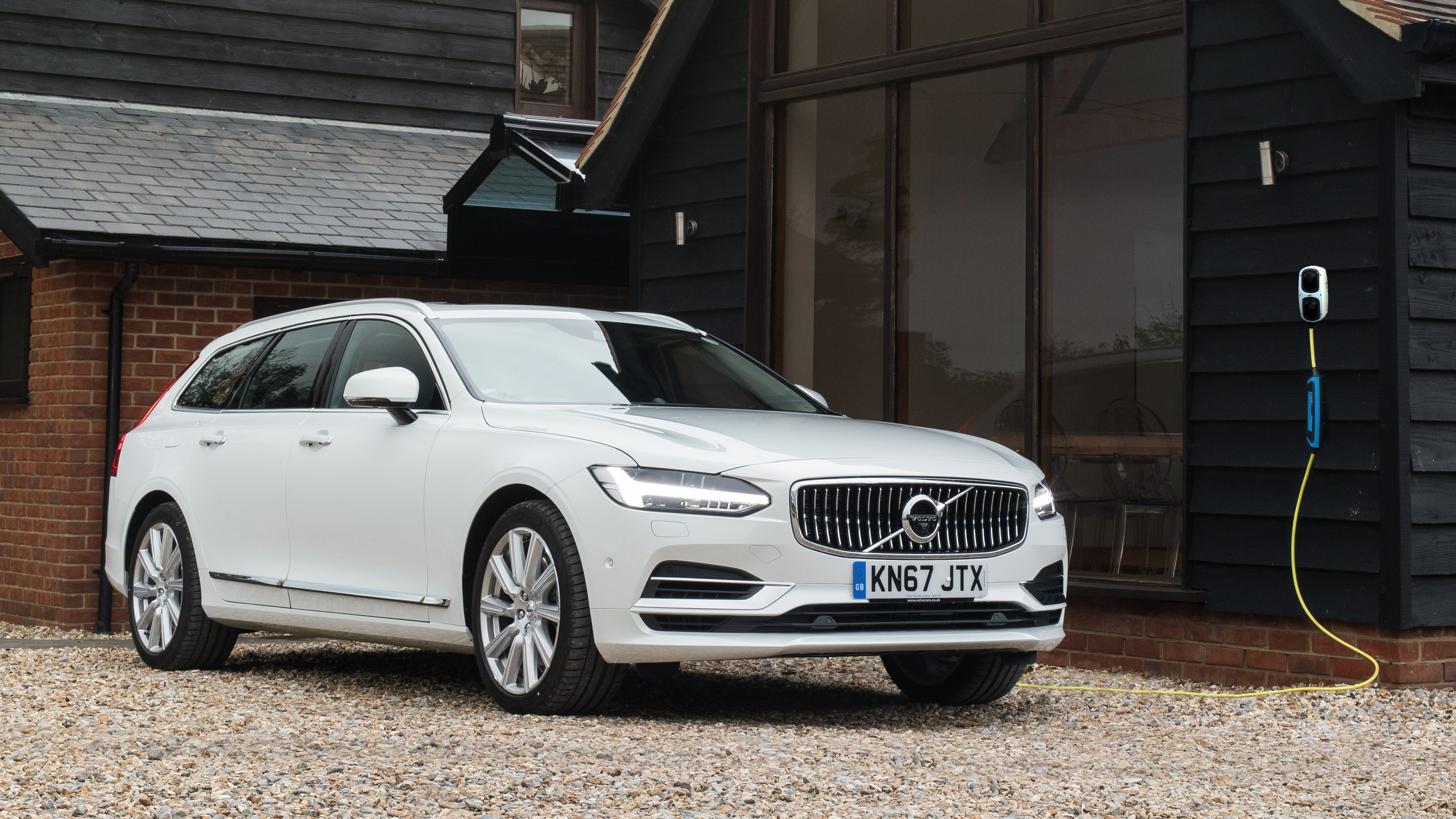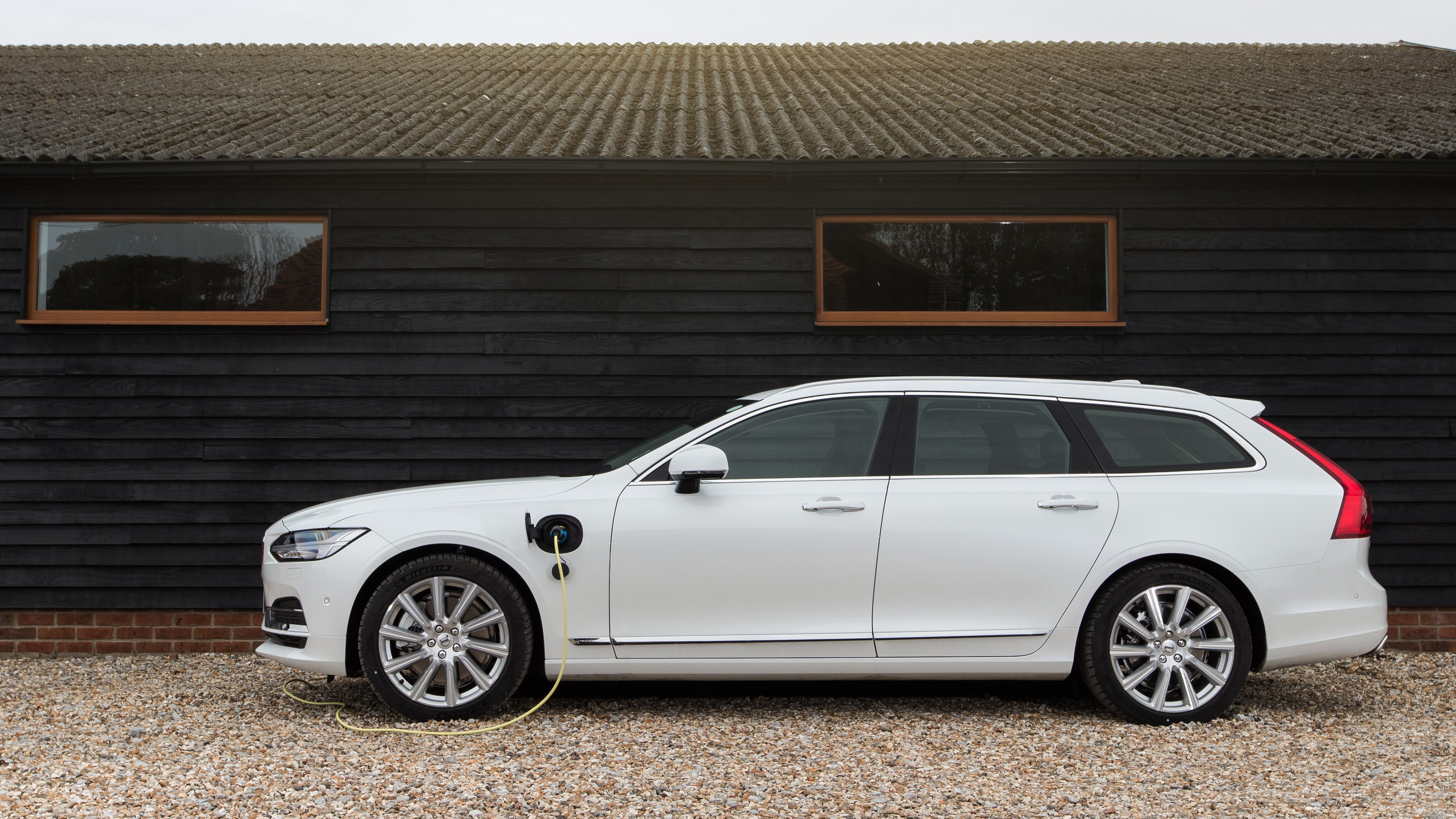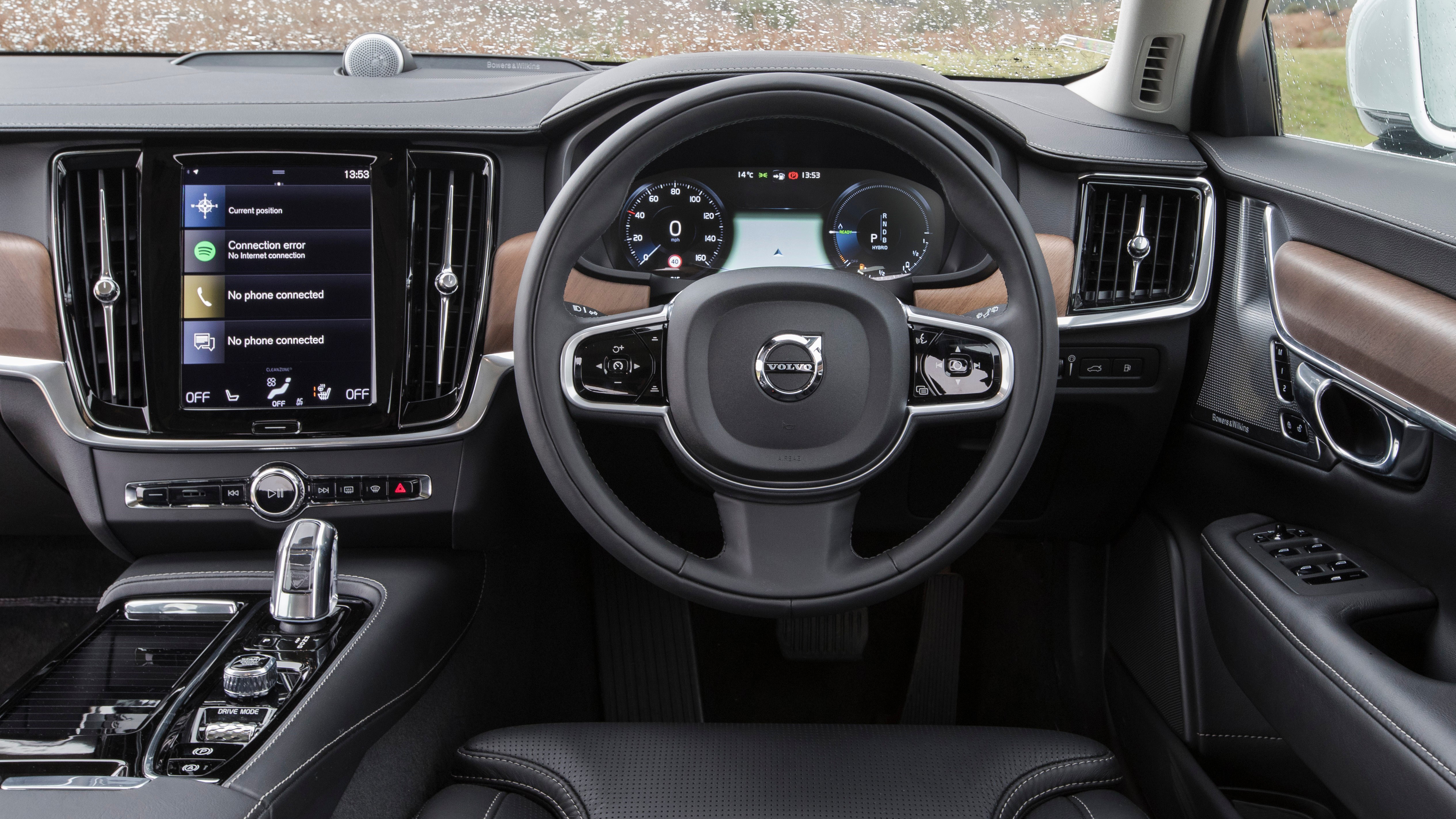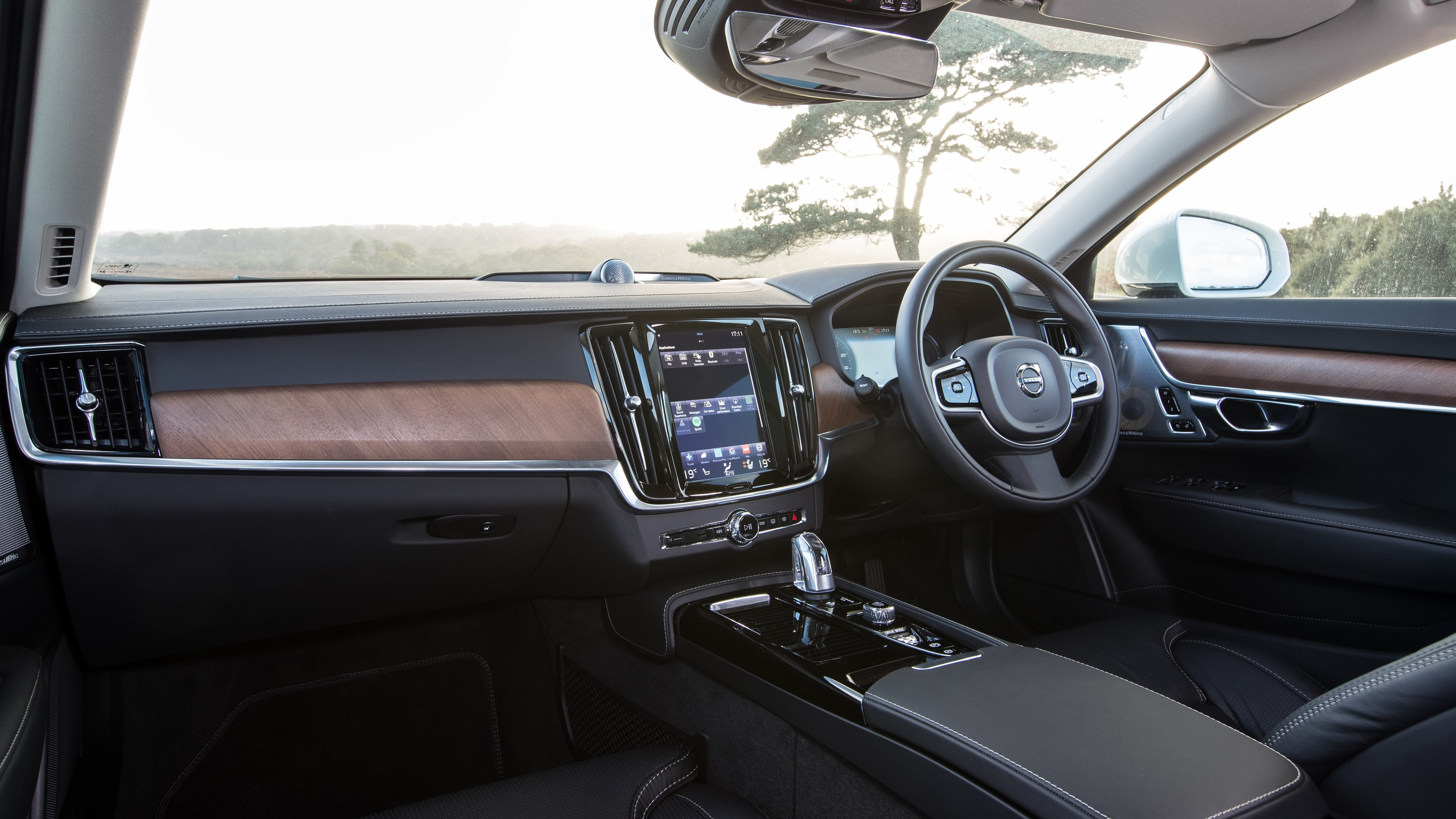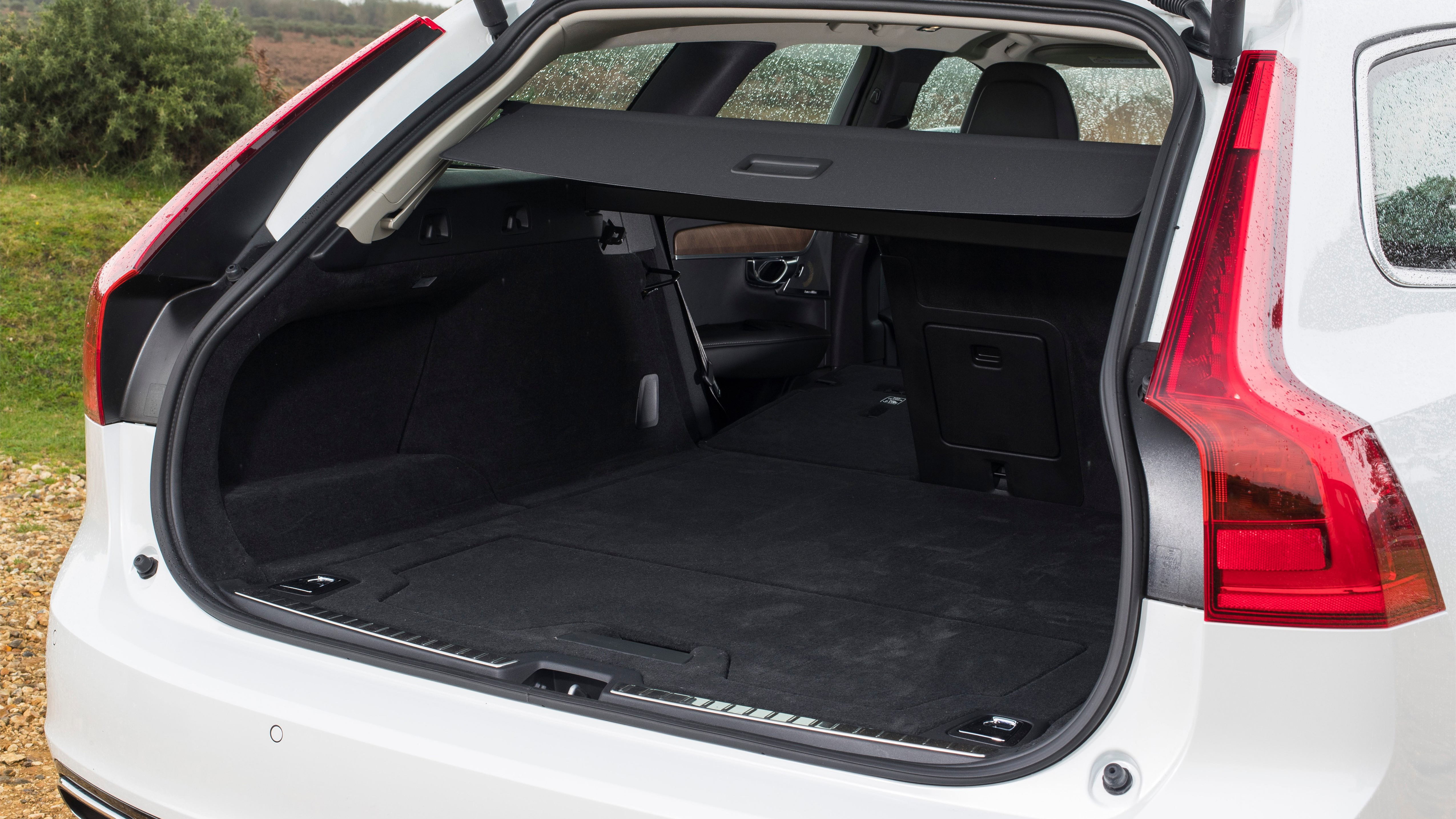
SPEC HIGHLIGHTS
- Battery
Capacity10.4kWh
- BHP
407bhp
- 0-62
4.8s
- CO2
46g/km
- Max Speed
155Mph
We’ve met the Volvo ‘Twin Engine’ before, correct?
Indeedy, in the likes of the XC90 T8, and the new XC60. ‘Twin Engine’ is just a clever Volvo marketing person’s name for ‘hybrid’, and it just sounds like you’re getting more car for your money. This is the V90 estate version, which actually gets a bigger battery than the XC90 we weren’t convinced by.
Just to be clear, the set-up doesn’t actually stuff two engines under the bonnet. Volvo’s most powerful petrol engine (a 316bhp, turbocharged 2.0-litre four-cylinder) drives the front wheels, and turning the rears is an electric motor powered by a 10.4kWh battery. So, in effect, you’ve got an engine as powerful as a Honda Civic Type R’s working the fronts, and a 85bhp booster out back.
You do the maths, please.
Total system power is rated at 401bhp and 472lb ft, so you’d expect this to be a fast PHEV (plug-in hybrid electric vehicle).
Is it?
Ish. Volvo claims 4.8 seconds to 62mph and 155mph, but it never pins you back in the world-class seat from getaway, because there’s so much weight to lever away along with the impatient human. That battery, strung out like a spine where the transmission tunnel would usually bisect the cabin, contributes to a gigantic kerbweight of 2,011kg.
That’s 228kg heavier than the most powerful turbodiesel V90 you can get (the D5) which is also all-wheel drive. Heck, this thing’s 60kg heavier than an V8-powered Audi RS6 Avant.
Best not to think of this a flagship fast estate, then. Is it more of a luxury item?
Yup, despite the availability of bodykitted R-design trim for your hybrid V90, dignified, understated Inscription Pro guise is where the big Swedish barge feels far more comfortable.
Top Gear
Newsletter
Thank you for subscribing to our newsletter. Look out for your regular round-up of news, reviews and offers in your inbox.
Get all the latest news, reviews and exclusives, direct to your inbox.
It starts at £59,705, and as it’s the peak of the 90-series cars, it gets 19-inch wheels, sound-muffling laminated windows, plus heated washer jets to keep the heated windscreen extra-toasty while you grip a heated leather steering wheel. There’s electric massaging seats and Volvo’s sublime 9-inch touchscreen centerpiece, though to really cherry-top the cabin the stunning B&W hi-fi is £3,000. It’s all utterly beautifully put together, and so much more welcoming inside than the austere German alternatives.
Speaking of which, the V90 has a bit of an open goal here. Both the BMW 530e iPerformance and Mercedes E350e PHEVs are saloon-only. German thinking says if you want a big, dog-friendly boot on the back of your posh hybrid, you want a giant SUV. Volvo will do you one of those two, or a saloon S90 Twin Engine, but the estate hasn’t been forgotten. We like that.
But do we like the all-important economy?
Less so. First up, the claims. Like all plug-ins, the V90 aces the Euro-cycle eco test, scoring 141mpg and 41g/km with a completely straight face. Volvo reckons on the usual 31 miles of electric only range (a nice round 50km) following a seven-hour household socket charge, or three hours next to a wallbox.
Hmm. After over 12 hours charging at the Top Gear office, our V90 reckoned on 21 miles of E-range. With a full tank of petrol (50 litres in the T8, versus 60 litres in the D5), estimated range was an unimpressive 380 miles. More than any current EV, granted, about 100 miles below what TG’s long-term V90 D5 would do on one tank of diesel, averaging 37.5mpg over six months. Remember that fuel reading…
Why, what did the V90 T8 manage?
Over a couple of hundred miles, following a full charge? A claimed 37.5mpg. Exactly the same as the diesel. As ever with PHEVs, you’ve got to use them exactly as intended. There’s very little leeway for human error in their prescriptive, do-as-I-need make-up.
As ever, there are modes that lurk in a sub-menu to set the car’s mood for what you’re intending on doing, but given it defaults to ‘Hybrid Everyday Driving’ whenever you start it up, that’s clearly where Volvo thinks the T8’s comfort zone is. Here, it’s very tricky to maintain EV progress. Almost Prius-like, in fact. The virtual instrument dials are great at alerting how much toe-prod on throttle you are away from rousing the petrol engine, but unless you’re really mired in traffic, this is not a hybrid that wants to moonlight as a full EV. Not compared to say, the BMW 530e, which will tack down an autobahn with the engine asleep.
As luck would have it, I had a long journey to do and the first hour of it was spent in London gridlock. Picking the lock of West London rat runs added up to 18 miles, according to a Google Maps recount, and that’s exactly how long the battery lasted. Close to the car’s readout, but way off the 31 miles stated. Instant mpg readout: 65.7mpg.
Then, an hour of schleppy cruising on an unusually free-flowing M40. The V90 loves motorways. Its gait is relaxed and long-legged. The engine start-up is like a vegan barbeque – utterly jerk-free – and as near as dammit silent.
You stride along cosseted in that magnificent cabin, appreciating the blissful ergonomics, delightful smelling leathers and light, unlaquered woods, the supremely comfortable, weightless seats, and struggle to think of a car, Rolls-Royce Phantom aside, which could possibly relax you as much as the Volvo does at this very moment. But the engine is drinking as it hauls along nearly 2.1 tonnes of flat-battery Volvo. Instant mpg readout: 41.2mpg.
Then comes the bookend of the journey: a 10-mile wind through Northamptonshire’s picturesque but pockmarked A-roads. The Volvo’s battery is totally bereft of charge, so economy is dropping like the approval ratings of a president who’s forgotten to build his wall.
Meanwhile, the T8’s weight gain means it’s less keen for a corner than an XC90, and the ride is more brittle than other Volvos because the body control is sagging under the strain, Even driving sympathetically, economy settles at 37.5mpg. I can practically hear the battery begging to be charged. Yes, this can be done on the move, but the extra resistance leaves the petrol engine drinking like a squaddie on leave. Like it does in all PHEVs, in fact.
So what if it’s not as flexible as a diesel. TDIs are hardly flavour of the month?
Quite – in fact, as you’ve probably heard, Volvo’s already said it’s killed off all internal diesel development, and is spending the R&D budget on batteries and motors for itself and Polestar. And when the cells offer a superior real-world range, a Twin Engine PHEV might well suit a Volvo product better than any other big executive barge.
As for now, this is a tax incentive first, and a balanced hybrid second. And if you’re interested in saving money, and can do without an estate, the BMW 5 Series hybrid offers similar returns for £15,000 less than the handsome Swede.
Or, for the tl;dr crew: as per with any PHEV – Volvo or otherwise – it only works if your lifestyle works around it.
Featured





